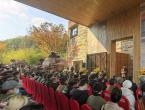famous forgeries exhibited at the National Archives of France
On October 15th, local time, the National Archives of France held an exhibition in Paris to showcase famous forgeries in history. The exhibition featured about a hundred famous forgeries from the medieval times to modern times, ranging from counterfeit currency to imitation artworks and counterfeit goods, aiming to enhance the public's ability to distinguish various forgeries.
In people's impression, high-level and high-quality works are always chosen for holding high-end exhibitions. However, what is greatly unexpected is that the French National Archives held an exhibition in Paris, which surprisingly exhibited "about a hundred famous forgeries from the Middle Ages to modern times". Calm down and think about it, in fact, from the original intention of the exhibition - "aimed at improving the public's ability to distinguish various forgeries", this exhibition is not only unique and creative, but also has great appeal and depth.
In fact, whether it's forgery, imitation (unless publicly labeled) or counterfeiting, these phenomena have emerged almost alongside the advent of currency, artworks, and commodities. Not only are there forgeries, imitations, and counterfeits produced during the same dynasty, but there are also forgeries, imitations, and counterfeits produced by later dynasties to imitate those of earlier dynasties. Why are some people so keen on this? Because producing counterfeits is low-cost and high-value-added, making it inevitable for some people to be drawn to it.
As time goes by, especially with the continuous upgrading of counterfeiting, imitation, and forgery technologies, some counterfeits of currency, artworks, and commodities have almost reached the level of being indistinguishable from the real thing. Take, for instance, the most eye-catching exhibit in this exhibition—the crystal skull. It was once collected by Western museums as an archaeological artifact in the 19th century. However, in the 20th century, experts identified it as not being made by ancient craftsmen but rather being produced in the 19th century. It is regarded as one of the most famous counterfeits in history. If we say that this collection played a huge trick on Western museums, one of the important reasons lies in the continuous upgrading of counterfeiting, imitation, and forgery technologies.
In some domestic collectibles markets, the situation of fake items being mixed with genuine ones has reached an extreme, leading to frequent deception and betrayal of collectors. Some counterfeits have even deceived individual renowned experts. Ultimately, the inability to identify fakes stems from the fact that the discernment of collectors lags behind the speed and pace of counterfeiting, imitation, and forgery techniques. So, how can we help more collectors quickly enhance their discernment and collecting skills? Besides strengthening theoretical knowledge, visiting national museums and large auctions, and frequently consulting with appraisal experts and antique dealers, conducting detailed comparisons between the specific appearance and processing techniques of genuine and fake collectibles is also an effective approach.
In fact, the aforementioned exhibition showcases the comparison between genuine and counterfeit goods, including gold bars, tobacco, alcohol, cosmetics, jewelry, and more. As the saying goes, "Only through comparison can one discern." Whether it's goods or collectibles, once they are compared, their quality and authenticity will immediately become apparent, from their overall appearance to their detailed expression. This reminds me of a clever trick a foreign banker taught his staff to quickly identify counterfeit currency: observe, study, and touch genuine currency frequently, until you have a deep understanding of it. This way, once a counterfeit currency appears, you can identify it with certainty. This method really works. It's like a pair of twins, no matter how similar they look physically, others may find it hard to distinguish between them, but in the eyes of their parents, it's crystal clear who is the older and younger sibling. The reason is that parents have lived with their children for a long time and are too familiar with their children's demeanor, temperament, and behavior. Sometimes, even if they don't see their children, a shout or even a laugh can serve as a basis for parents to distinguish between them. If collecting can reach this level, the probability of successfully identifying authenticity will be greatly increased.
Paying attention to the comparison between the production processes of genuine and counterfeit items is also an important means of identifying authentic and fake collectibles. This is because there are significant differences in the production processes of genuine and fake collectibles. Only by deeply understanding their different production processes can one discern their authenticity through aspects such as material selection and use, processing procedures, and quality assurance. In the aforementioned exhibition, the Banque de France provided uncut genuine 50-euro banknotes for the exhibition and introduced the printing process of banknotes. The purpose was to help the public see the strict and standardized characteristics of the printing process of genuine banknotes, thereby making it easier for visitors to identify the authenticity of banknotes. This also inspires us: it may be worthwhile to learn about and reconstruct the production processes of some counterfeit and inferior collectibles through various means, to capture and discover their characteristics of being random and non-standardized, crude and not refined, incomplete and incomplete, and then to accurately identify "obvious fakes" through differences in details.
In today's market, where counterfeit and inferior collectibles continue to flood the scene, it is imperative for collectors to sharpen their eyes and equip themselves with knowledge. Particularly, enhancing their discernment skills in appraisal and collecting is crucial, aiming to minimize or avoid being deceived. In this sense, strengthening the comparison between genuine and fake collectibles, as well as their production techniques, emerges as a significant approach.
Copyright Notice: Original content on this website is welcome to be reposted. Please indicate the source when reposting, Global Art Network www.caanets.com; Some of the content posted on this website comes from the internet. If there is any infringement, please contact this website to delete it.




